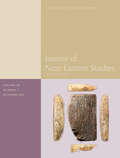 Journal of Near Eastern Studies, volume 80 number 2 (October 2021)
5198144
Journal of Near Eastern Studies, volume 80 number 2 (October 2021)
5198144
|
Journal of Near Eastern Studies
|
9780226913377 |
2021 |
Contains images
|
|
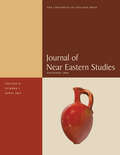 Journal of Near Eastern Studies, volume 81 number 1 (April 2022)
5229694
Journal of Near Eastern Studies, volume 81 number 1 (April 2022)
5229694
|
Journal of Near Eastern Studies
|
9780226914909 |
2022 |
Contains images
|
|
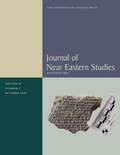 Journal of Near Eastern Studies, volume 81 number 2 (October 2022)
5229695
Journal of Near Eastern Studies, volume 81 number 2 (October 2022)
5229695
|
Journal of Near Eastern Studies
|
9780226916477 |
2022 |
Contains images
|
|
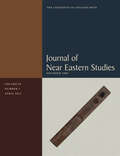 Journal of Near Eastern Studies, volume 82 number 1 (April 2023)
5249492
Journal of Near Eastern Studies, volume 82 number 1 (April 2023)
5249492
|
Journal of Near Eastern Studies
|
9780226918204 |
2023 |
Contains images
|
|
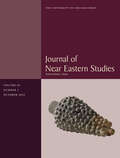 Journal of Near Eastern Studies, volume 82 number 2 (October 2023)
5666171
Journal of Near Eastern Studies, volume 82 number 2 (October 2023)
5666171
|
Journal of Near Eastern Studies
|
9780226920030 |
2023 |
Contains images
|
|
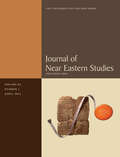 Journal of Near Eastern Studies, volume 83 number 1 (April 2024)
5985463
Journal of Near Eastern Studies, volume 83 number 1 (April 2024)
5985463
|
Journal of Near Eastern Studies
|
9780226000237 |
2024 |
Contains images
|
|
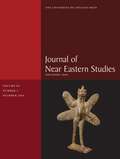 Journal of Near Eastern Studies, volume 83 number 2 (October 2024)
6201673
Journal of Near Eastern Studies, volume 83 number 2 (October 2024)
6201673
|
Journal of Near Eastern Studies
|
9780226002880 |
2024 |
Contains images
|
|
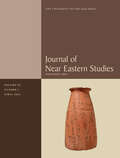 Journal of Near Eastern Studies, volume 84 number 1 (April 2025)
6511539
Journal of Near Eastern Studies, volume 84 number 1 (April 2025)
6511539
|
Journal of Near Eastern Studies
|
9780226004563 |
2025 |
Contains images
|
|
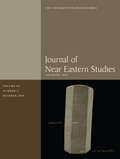 Journal of Near Eastern Studies, volume 84 number 2 (October 2025)
6822760
Journal of Near Eastern Studies, volume 84 number 2 (October 2025)
6822760
|
Journal of Near Eastern Studies
|
9780226006482 |
2025 |
Contains images
|
|
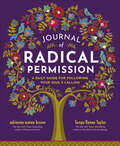 Journal of Radical Permission: A Daily Guide for Following Your Soul's Calling
6467396
Journal of Radical Permission: A Daily Guide for Following Your Soul's Calling
6467396
|
Adrienne Maree Brown
Sonya Renee Taylor
|
9781523002443 |
2022 |
Contains images
|
|
 Journal of Soviet and Post-Soviet Politics and Society: Double Special Issue: Back from Afghanistan: The Experiences of Soviet Afghan War Veterans, Vol. 1, No. 2 (2015)
3509464
Journal of Soviet and Post-Soviet Politics and Society: Double Special Issue: Back from Afghanistan: The Experiences of Soviet Afghan War Veterans, Vol. 1, No. 2 (2015)
3509464
|
Assistant Public Joanne Raymond
|
9783838268064 |
2015 |
Contains images
|
|
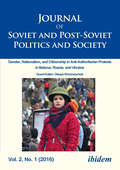 Journal of Soviet and Post-Soviet Politics and Society: Gender, Nationalism, and Citizenship in Anti-Authoritarian Protests in Belarus, Russia, and Ukraine, Vol. 2, No. 1 (2016)
3510724
Journal of Soviet and Post-Soviet Politics and Society: Gender, Nationalism, and Citizenship in Anti-Authoritarian Protests in Belarus, Russia, and Ukraine, Vol. 2, No. 1 (2016)
3510724
|
Assistant Public Joanne Raymond
|
9783838268866 |
2016 |
Contains images
|
|
 Journal of Soviet and Post-Soviet Politics and Society: The Russian Media and the War in Ukraine, Vol. 1, No. 1 (2015)
3515742
Journal of Soviet and Post-Soviet Politics and Society: The Russian Media and the War in Ukraine, Vol. 1, No. 1 (2015)
3515742
|
Julie Fedor
|
9783838267265 |
2015 |
Contains images
|
|
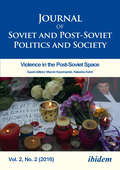 Journal of Soviet and Post-Soviet Politics and Society: Violence in the Post-Soviet Space, Vol. 2, No. 2 (2016)
3508849
Journal of Soviet and Post-Soviet Politics and Society: Violence in the Post-Soviet Space, Vol. 2, No. 2 (2016)
3508849
|
Assistant Public Joanne Raymond
|
9783838269481 |
2017 |
Contains images
|
|
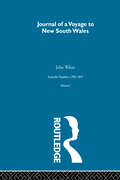 Journal of a Voyage to New South Wales: Scientific Travellers 1790-1877 Volume 1
6119729
Journal of a Voyage to New South Wales: Scientific Travellers 1790-1877 Volume 1
6119729
|
John White
|
9781040249543 |
2003 |
Contains images
|
|
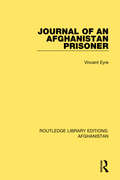 Journal of an Afghanistan Prisoner (Routledge Library Editions: Afghanistan #1)
3581721
Journal of an Afghanistan Prisoner (Routledge Library Editions: Afghanistan #1)
3581721
|
Vincent Eyre
|
9781000103922 |
1976 |
Contains images
|
|
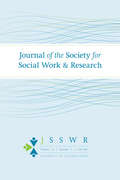 Journal of the Society for Social Work and Research, volume 12 number 3 (Fall 2021)
4222740
Journal of the Society for Social Work and Research, volume 12 number 3 (Fall 2021)
4222740
|
Journal of the Society for Social Work and Research
|
9780226912974 |
2021 |
Contains images
|
|
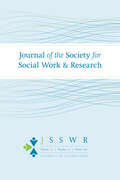 Journal of the Society for Social Work and Research, volume 12 number 4 (Winter 2021)
4350663
Journal of the Society for Social Work and Research, volume 12 number 4 (Winter 2021)
4350663
|
Journal of the Society for Social Work and Research
|
9780226913926 |
2021 |
Contains images
|
|
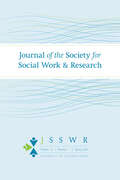 Journal of the Society for Social Work and Research, volume 13 number 1 (Spring 2022)
4484322
Journal of the Society for Social Work and Research, volume 13 number 1 (Spring 2022)
4484322
|
Journal of the Society for Social Work and Research
|
9780226914824 |
2022 |
Contains images
|
|
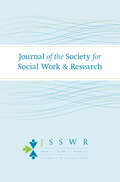 Journal of the Society for Social Work and Research, volume 13 number 2 (Summer 2022)
4624597
Journal of the Society for Social Work and Research, volume 13 number 2 (Summer 2022)
4624597
|
Journal of the Society for Social Work and Research
|
9780226915883 |
2022 |
Contains images
|
|
 Journal of the Society for Social Work and Research, volume 13 number 3 (Fall 2022)
4895019
Journal of the Society for Social Work and Research, volume 13 number 3 (Fall 2022)
4895019
|
Journal of the Society for Social Work and Research
|
9780226916491 |
2022 |
Contains images
|
|
 Journal of the Society for Social Work and Research, volume 13 number 4 (Winter 2022)
5131497
Journal of the Society for Social Work and Research, volume 13 number 4 (Winter 2022)
5131497
|
Journal of the Society for Social Work and Research
|
9780226917320 |
2022 |
Contains images
|
|
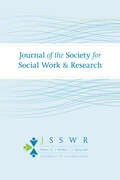 Journal of the Society for Social Work and Research, volume 14 number 1 (Spring 2023)
5251897
Journal of the Society for Social Work and Research, volume 14 number 1 (Spring 2023)
5251897
|
Journal of the Society for Social Work and Research
|
9780226918259 |
2023 |
Contains images
|
|
 Journal of the Society for Social Work and Research, volume 14 number 2 (Summer 2023)
5379782
Journal of the Society for Social Work and Research, volume 14 number 2 (Summer 2023)
5379782
|
Journal of the Society for Social Work and Research
|
9780226919287 |
2023 |
Contains images
|
|
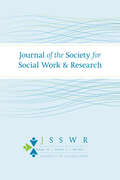 Journal of the Society for Social Work and Research, volume 14 number 3 (Fall 2023)
5638629
Journal of the Society for Social Work and Research, volume 14 number 3 (Fall 2023)
5638629
|
Journal of the Society for Social Work and Research
|
9780226919898 |
2023 |
Contains images
|
|